Quarterly Banking Profile - Third Quarter 2022
Good morning, and welcome to our release of third quarter 2022 performance results for FDIC-insured institutions.
The banking industry reported continued positive results this quarter amidst persistent economic uncertainty. Net interest income grew, loan growth continued, and asset quality measures remained favorable.
The banking industry reported an increase in quarterly net income from last quarter and one year ago, primarily due to improved net interest income. This more than offset an increase in provision expenses—the amount set aside by institutions to protect against future credit losses.
Net income also increased from last quarter and year over year at community banks. Higher net interest income more than offset increases in noninterest expense and declines in noninterest income from lower net gains on loan sales.
Rising market interest rates and strong loan growth supported a substantial increase in the net interest margin from the second quarter. Most banks reported higher net interest income compared with last quarter.
However, additional interest rate increases combined with longer asset maturities may present challenges for the banking industry in coming quarters. Unrealized losses on available-for-sale and held-to-maturity securities totaled $690 billion, up 47 percent from second quarter 2022.
The Deposit Insurance Fund (DIF) balance was $125.5 billion on September 30, up $1.0 billion from the end of the second quarter. The reserve ratio was unchanged at 1.26 percent, as insured deposits grew 0.1 percent.
Despite several favorable performance metrics in the third quarter, the banking industry continues to face significant downside risks. These risks include the effects of inflation, rising market interest rates, and continued geopolitical uncertainty. Taken together, these risks may reduce profitability, weaken credit quality and capital, and limit loan growth in coming quarters. Furthermore, higher market interest rates have led to continued growth in unrealized losses in the banking industry’s securities portfolios. Higher market interest rates may also erode real estate and other asset values as well as hamper borrowers’ loan repayment ability. These will be matters of ongoing supervisory attention by the FDIC.
Chart 1:
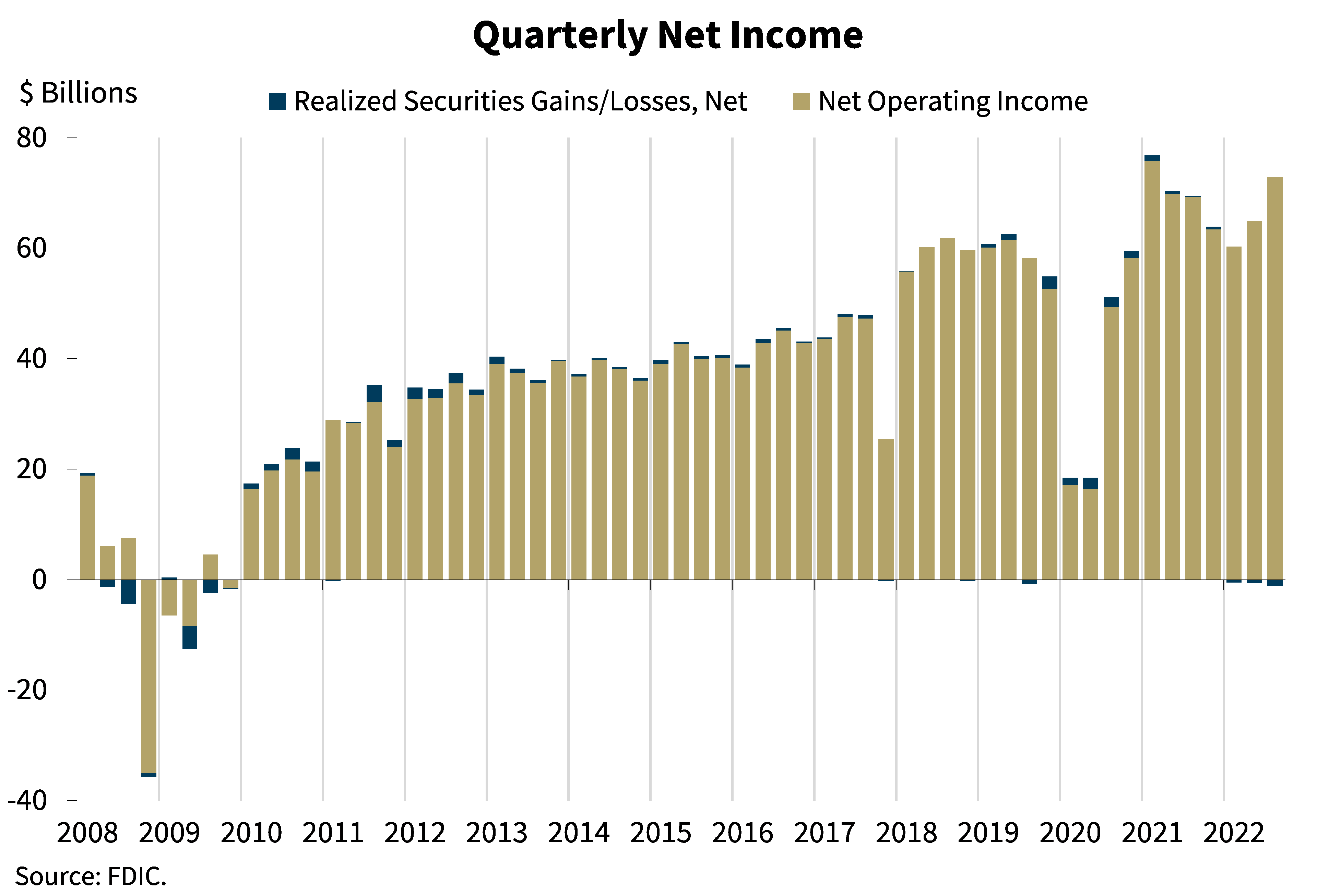
As shown in this chart, the banking industry reported net income of $71.7 billion in the third quarter, up $7.3 billion (or 11.3 percent) from the prior quarter and $2.2 billion (or 3.2 percent) from the third quarter last year.
Strong growth in interest income outpaced growth in interest expense, pushing net interest income up 11.6 percent quarter over quarter. The growth in net interest income outpaced the increase in provision expense from the prior quarter.
At some point, we would expect the gap between interest income and expenses to narrow as market forces place pressure on banks to raise deposit rates faster than they have to date. The banking industry reported that the cost of deposits increased by 34 basis points in the third quarter, while yields on loans rose 65 basis points.
Compared with the industry, community banks reported a stronger increase in net income from the year-ago quarter. Net income for community banks increased $1.0 billion (or 13.5 percent) from one quarter ago.
Chart 2:
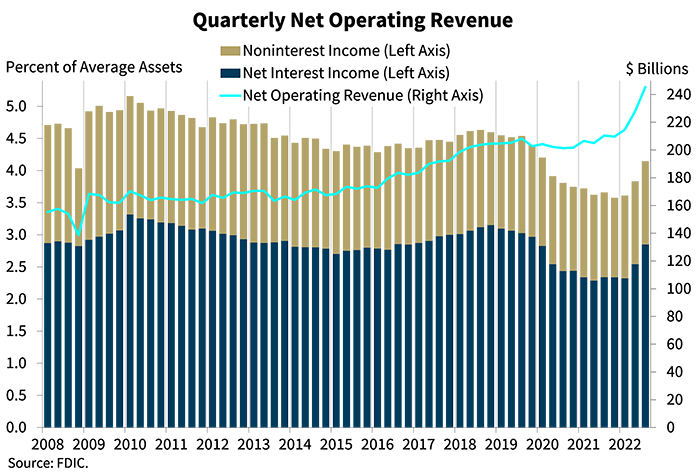
Our next chart shows that quarterly net operating revenue increased 7.6 percent from second quarter 2022 to $245.4 billion. Net interest income as a percentage of average assets increased from the second quarter, but remains slightly below the pre-pandemic level largely due to strong asset growth during the pandemic.
Noninterest income as a percentage of average assets was relatively flat from the second quarter, as the growth in noninterest income kept pace with average asset growth.
Chart 3:
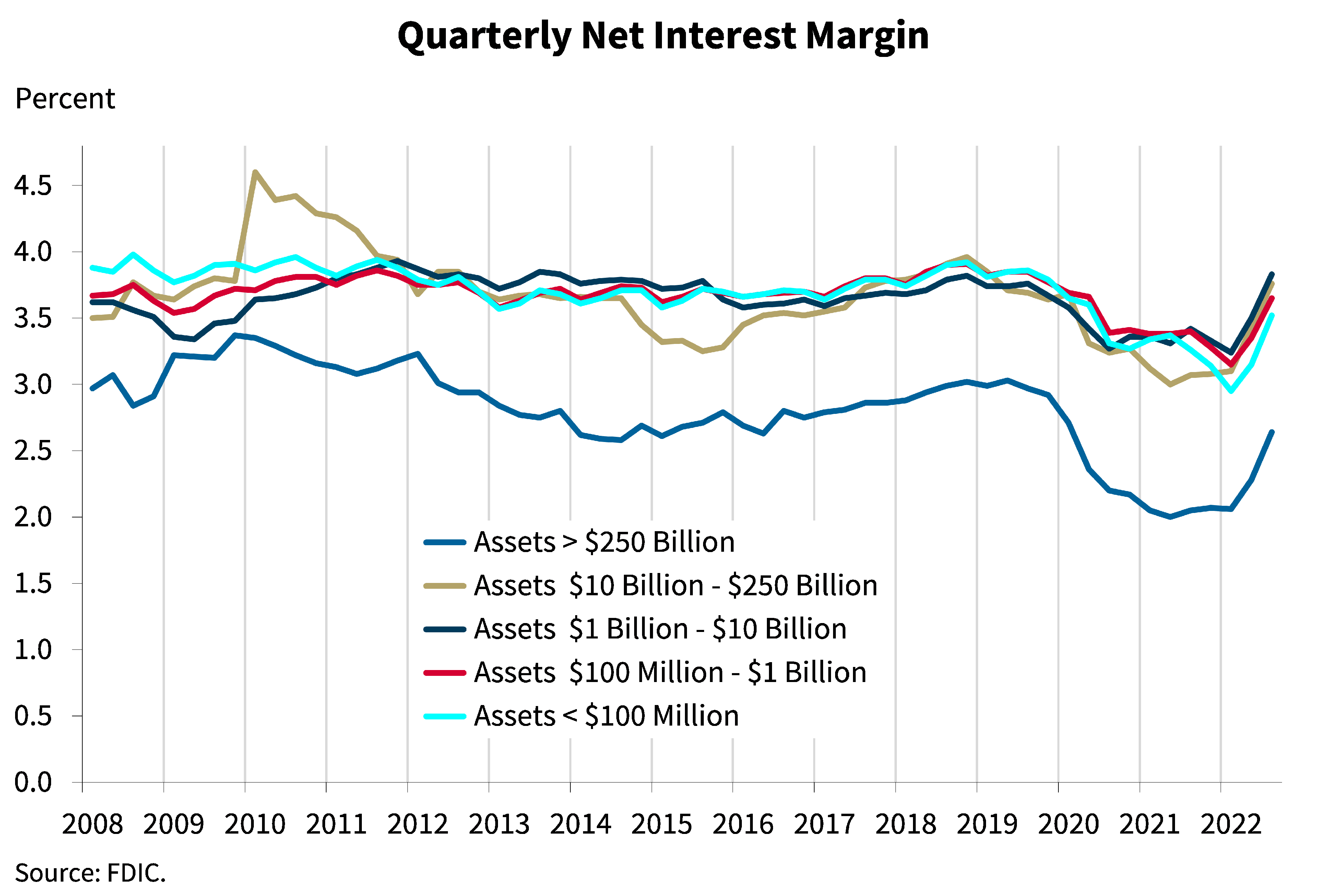
The next chart shows the net interest margin for the five asset size groups on which the QBP reports. The net interest margin for the banking industry as a whole widened significantly in the third quarter, increasing 35 basis points from last quarter to 3.14 percent. This is the largest quarter-over-quarter increase recorded in the history of the QBP, and all QBP asset size groups reported quarterly NIM growth. Despite the improvement, the net interest margin for the banking industry as a whole remains below the pre-pandemic average of approximately 3.25 percent.
The net interest margin for community banks also expanded, but by a smaller amount than the industry. The net interest margin at community banks widened 30 basis points from the last quarter to 3.63 percent.
Chart 4:
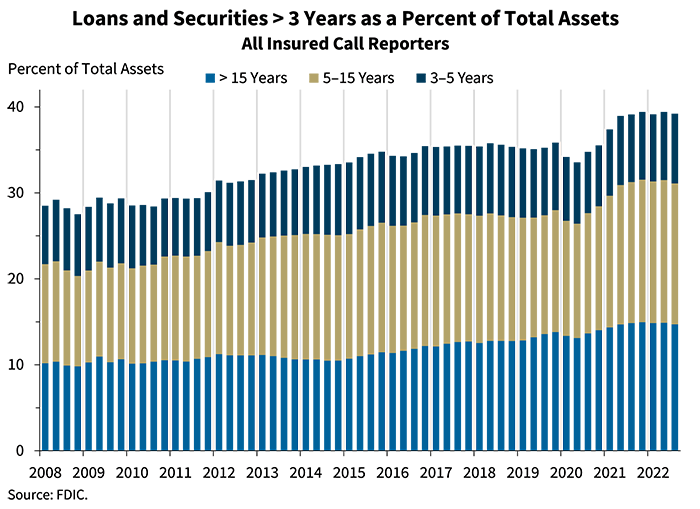
The next chart shows that the banking industry’s holdings of longer-term loans and securities remained elevated at 39.2 percent in the third quarter. Although this higher level of longer-term loans and securities helped preserve net interest margins during a period of lower interest rates, this strategy has contributed to the increase in the level of unrealized losses on investment securities as a result higher interest rates.
Compared with the industry, community banks continued to report a higher proportion of assets with maturities longer than three years, 54.4 percent of total assets.
Chart 5:

This chart shows the continued growth in unrealized losses on investment securities this quarter due to increases in market interest rates. Unrealized losses on available-for-sale and held-to-maturity securities totaled $690 billion, up 47 percent from second quarter 2022. The combination of a high level of longer-term asset maturities and a moderate decline in deposits underscores the risk that these unrealized losses could become actual losses should banks need to sell investments to meet liquidity needs.
Chart 6:
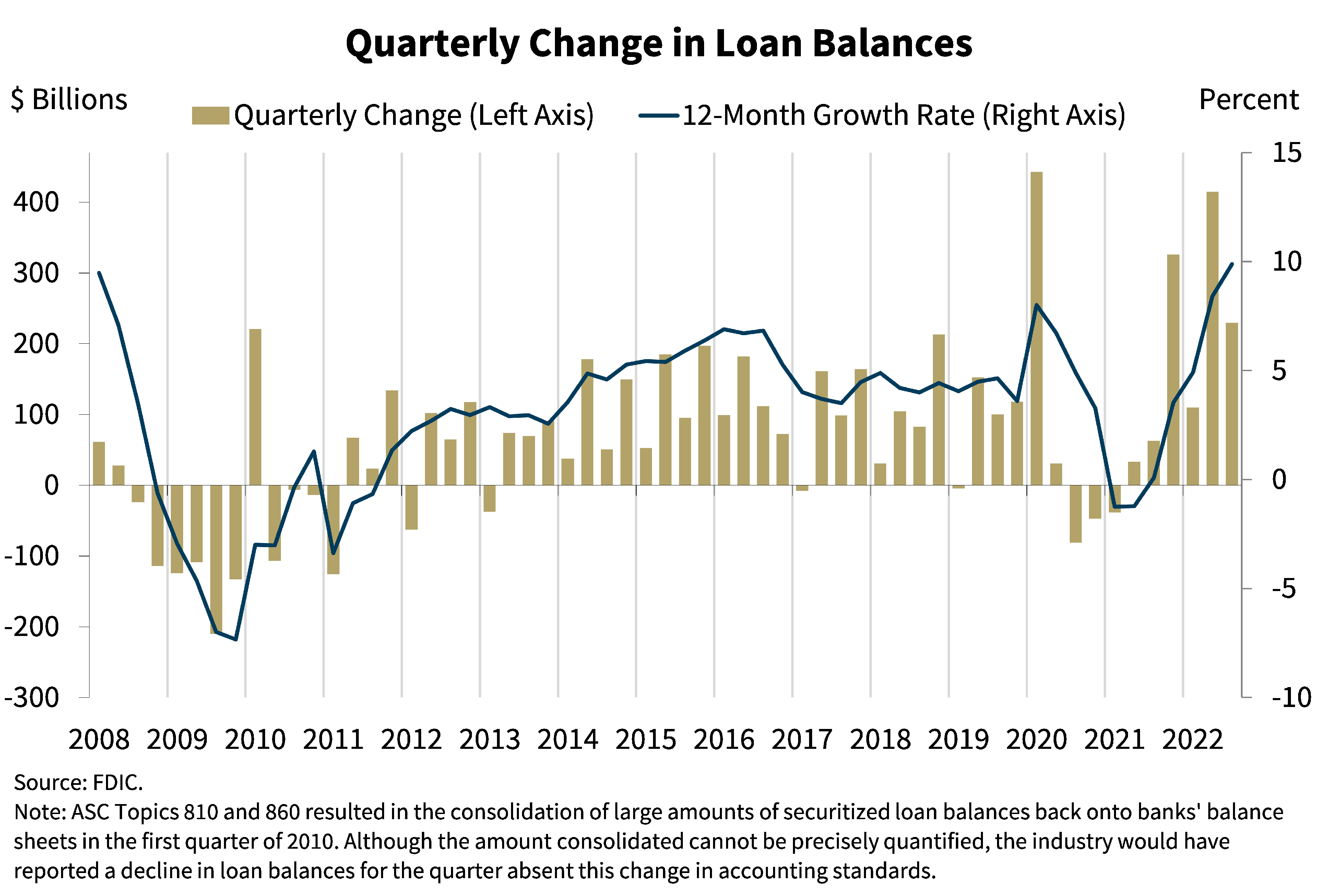
This chart shows that total loan balances grew for a sixth consecutive quarter. Loan growth for the industry exceeded the pre-pandemic average pace even without adjusting for the reduction in Paycheck Protection Program (PPP) loan balances.
The banking industry reported growth in several loan portfolios from the year-ago quarter, led by commercial & industrial (C&I) loans, one-to-four family residential mortgages, and consumer loans. Loan balances grew 9.9 percent from the previous year for the banking industry, the highest annual growth rate reported since second quarter 2006.
Compared to the industry, community banks reported stronger loan growth, increasing 12.2 percent year over year. Commercial real estate loan portfolios continued to drive annual loan growth for community banks.
PPP loan payoffs and forgiveness continued to affect loan growth rates. Excluding the effects of PPP loan payoffs, the annual loan growth rate would have been 11.6 percent for the industry and 15.7 percent for community banks.
Chart 7:

Our next chart shows that asset quality ratios for the industry remain favorable. The noncurrent and net charge-off rates are only slightly above historical lows. The noncurrent rate declined 3 basis points from second quarter to 0.72 percent, driven by reductions in noncurrent one-to-four family residential real estate loan balances. Increases in consumer loan net charge-offs, namely auto loan and credit card net charge-offs, drove a 6-basis point increase in the industry’s net charge-off rate from one year ago to 0.26 percent.
Like net charge offs, early delinquencies (loans past due 30-89 days) increased slightly from the year-ago quarter, also driven by past-due consumer loans in addition to C&I loans. These early delinquencies could be an indicator of future asset quality problems and will be an area of continued supervisory monitoring.
Community banks reported stable or improving credit quality metrics. The community bank noncurrent rate declined 4 basis points from the previous quarter to 0.47 percent—the lowest level on QBP record. The community bank net charge-off rate was unchanged from a year ago at 0.06 percent. But, like the industry, early delinquencies for community banks increased from the year-ago quarter, driven by an increase in past-due C&I and consumer loan balances.
Chart 8:
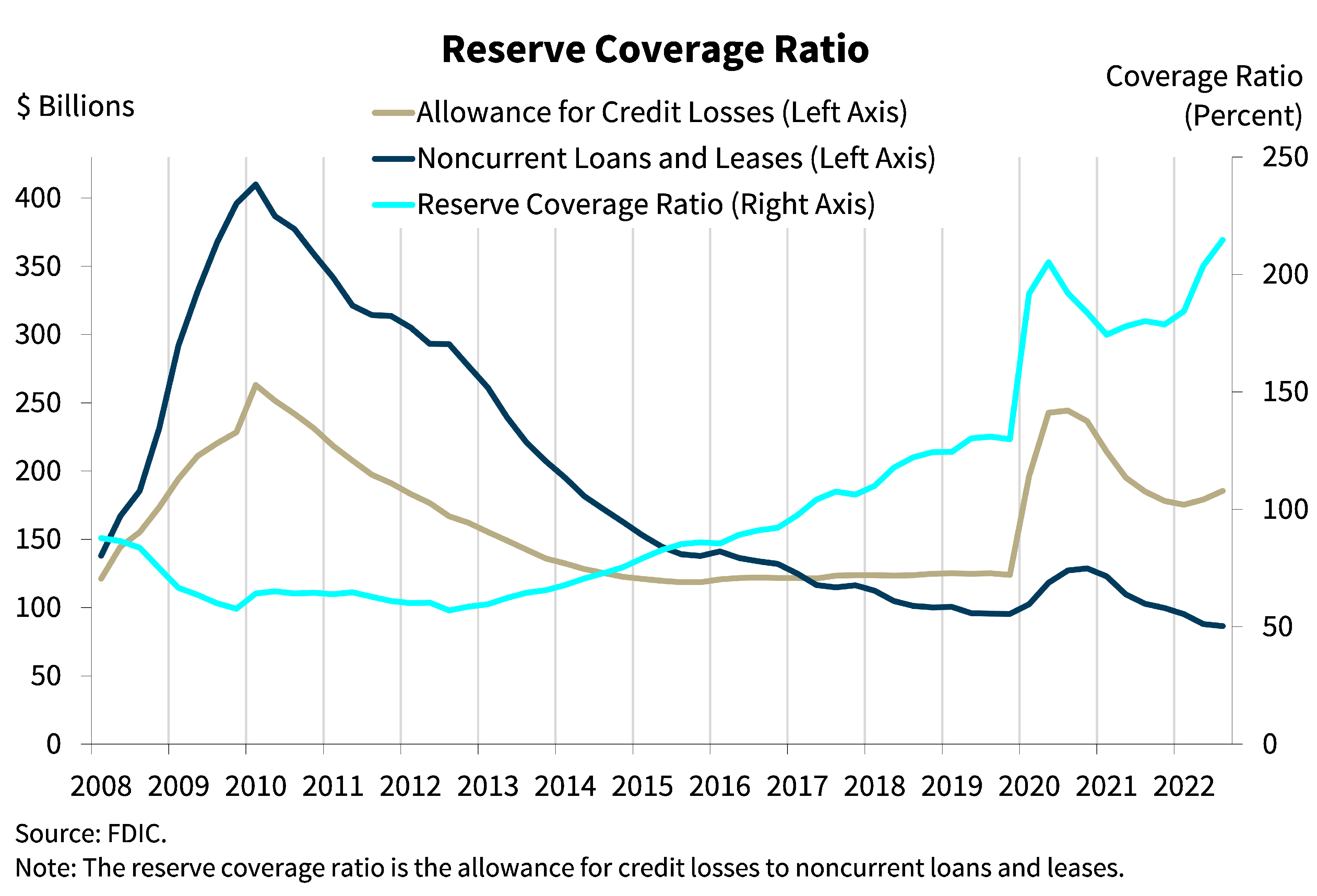
Our next chart shows that noncurrent loan balances fell while the allowance for credit losses grew year over year, resulting in an improvement in the average reserve coverage ratio. The ratio of credit loss reserves to noncurrent loans increased from 180.1 percent one year ago to 214.8 percent, the highest level on QBP record.
Chart 9:
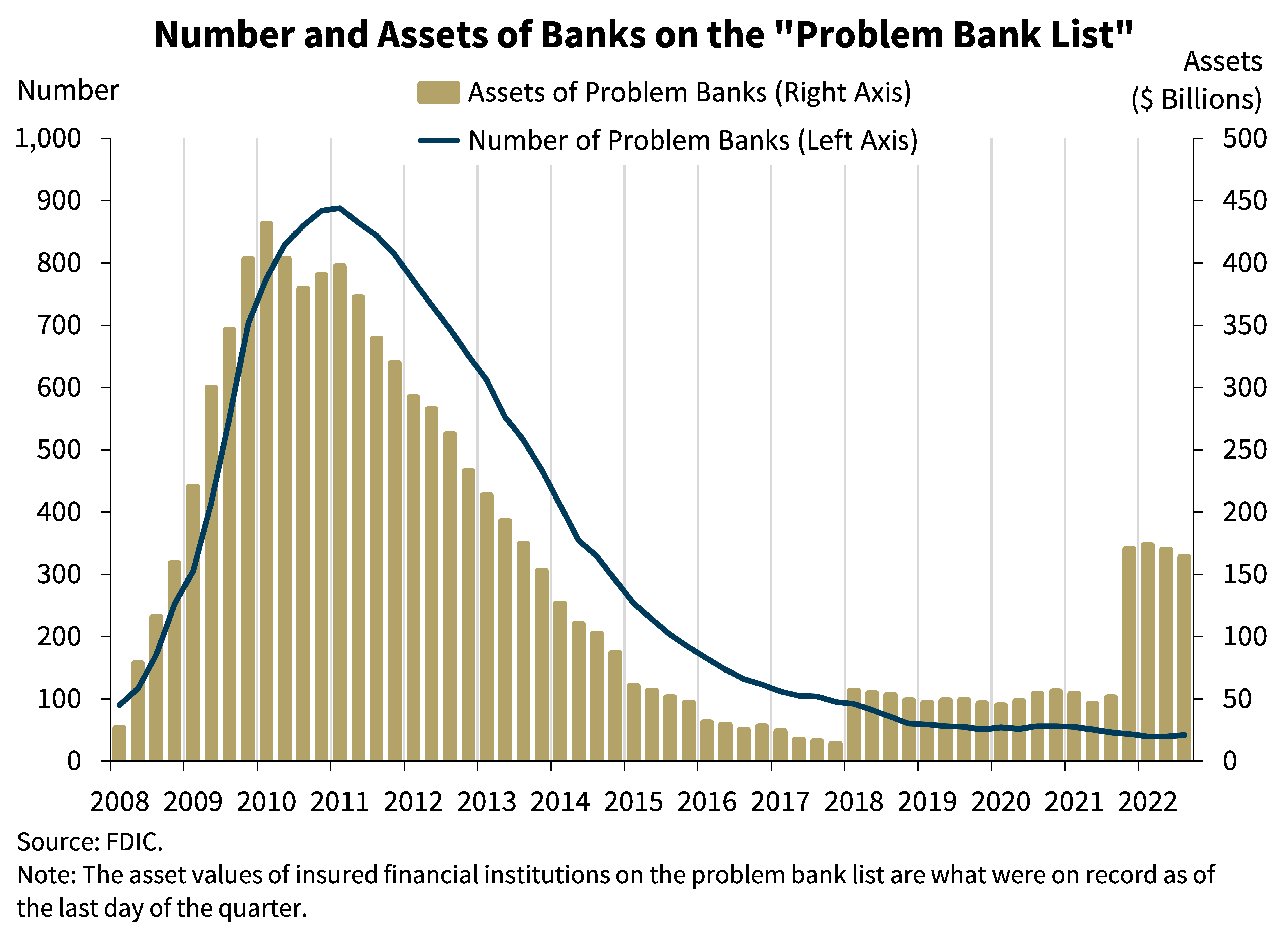
This next chart shows the number and total assets of banks on the “Problem Bank List.” The number of banks on the list increased by two from the previous quarter to 42 banks; however, total assets held by problem banks declined $5.7 billion to $163.8 billion in the third quarter. The number of problem banks remains near record low levels. No banks failed in the third quarter.
Chart 10:

This chart shows that deposits declined for a second consecutive quarter. A reduction in uninsured deposits was the primary driver of the quarterly decline while there was a small increase in insured deposits. Uninsured deposits have declined for three straight quarters.
Deposits totaled $19.4 trillion, down 1.1 percent from the level reported in the second quarter. While this reduction slightly offsets the unprecedented growth in deposits reported during the pandemic, total deposits are still well above pre-pandemic levels.
Chart 11:

This chart shows that the DIF balance was $125.5 billion on September 30, up approximately $1.0 billion from the second quarter. Assessment revenue was the primary driver of the increase in the fund, offset partially by unrealized losses on available-for-sale securities in the DIF portfolio that were driven by the rising interest-rate environment. Insured deposits increased by 0.1 percent during the third quarter. Year-over-year insured deposit growth was 3.5 percent. These factors caused the reserve ratio—the fund balance relative to insured deposits—to remain unchanged at 1.26 percent as of September 30 when compared to last quarter. This is 1 basis point lower than a year ago, when the reserve ratio was 1.27 percent.
The FDIC adopted a DIF Restoration Plan on September 15, 2020, that would return the reserve ratio to 1.35 percent, the statutory minimum, by September 2028 as required by law. As of September 30, 2022, the FDIC projected that the reserve ratio was still at risk of not reaching 1.35 percent by the statutory deadline. Therefore, in October, the FDIC Board finalized a rule to increase initial base deposit insurance assessment rates by 2 basis points, beginning in the first quarterly assessment period of 2023.
These actions were undertaken to improve the likelihood that the reserve ratio reaches the statutory minimum of 1.35 percent before the statutory deadline while reducing the potential for a pro-cyclical increase in assessment rates should the banking industry enter a period of stress in the interim.
In conclusion, overall, key banking industry metrics remain favorable at this time. Loan growth continued, net interest income grew, and asset quality measures remained favorable, despite a rise in early delinquencies. Further, the industry remains well-capitalized and highly liquid.
However, the banking industry continues to face downside risks resulting from economic uncertainties, inflationary pressures, rising interest rates, and geopolitical concerns. These factors could hamper bank profitability, weaken credit quality and capital, and limit loan growth. These risks will be matters of continued supervisory attention by the FDIC over the coming year.
Thank you.
I am happy to take your questions.
